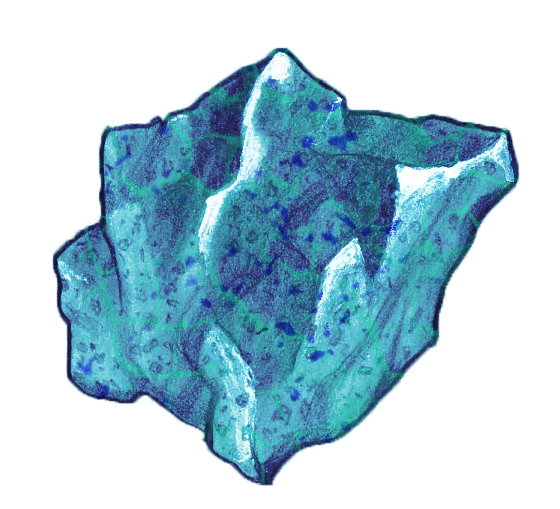Bluestone
“We already have enough bluestone to make us rich for decades. I’d rather be less rich and alive than be as rich as the emperor and dead. So what if we’re gone for five or ten years? That bluestone is going nowhere.”
Properties
Material Characteristics
A brilliant deep blue mineral, usually mixed in with quarts. It grows in faceted crystal shapes. Bluestone is unusually hard, require tremendous effort to mine and process.
History & Usage
History
The use of bluestone goes back at least as far as the foundation of Megaloth City which was founded in 211 A.C. It is recorded by Barth of Histories that the first Megaloth Emperor Trevor the Founder proposed that the entire Spire be covered in bluestone tile. Cooler heads prevailed and instead beaten metal sheets were used.
It is generally accepted that the royal garb of blue cape and crown were established simply because blue was the most expensive color available. And it remains so to this day.
Discovery
Because Rumsha first began mining the bluestone before humans discovered it, the actual date is unknown.
Cultural Significance and Usage
Because of the incredible risk required to extract the ore at The Bluestone Mines as well as the labor involved, the color blue is more expensive than any other covering with the exception of diamonds. So everything blue is perceived as lavish and/or royal.
Refinement
The process of extracting the pigment from the stone is a long and grueling one. First the stone must be crushed multiple times using sucessively refined milling techniques. After the power is fine enough it is mixed into melted pine rosin, gum mastic and beeswax. This mixture is then formed into rods, and left to cool for days. The process is repeated, the rods stretched and twisted for hours, then left to sit again. Finally the rods are bathed in warm water while being kneaded for many more hours. The pigment seeps out of the wax, into the water and precipitates to the bottom of the vessel. After the water is strained the rest evaporates leaving a brilliant blue pigment residue.
Manufacturing & Products
Bluestone pigment is used in paints, inks, ceramics, and fabric dyes. Due to the massive expense, blue objects are very costly.
Hazards
The pulverizing and milling processes creates fine silicate dust that eventually causes lung disease in most people who do such work.
Distribution
Trade & Market
The The Bluestone Miner's Union has the exclusive license to distribute and sell the pigment. They run an auction at the end of every mining cycle (usually between ten and twenty years)
Type
Ore/Mineral
Value
Very high
Rarity
Very rare




Comments